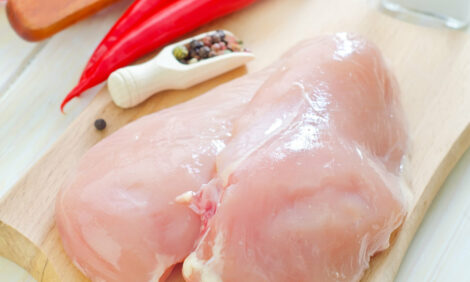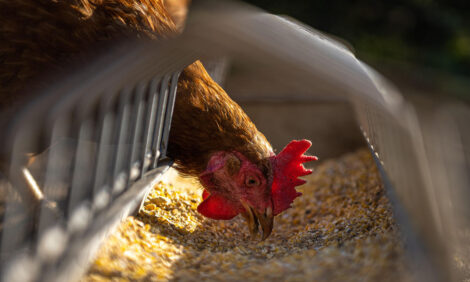



Japan's Poultry and Products Semi-Annual Overview - February 2005
By the USDA, Foreign Agricultural Service - This article provides the poultry industry data from the USDA FAS Poultry and Products Semi-Annual 2005 report for Japan. A link to the full report is also provided. The full report includes all the tabular data which we have ommited from this article.Report Highlights:
Japan’s broiler market is expected to recover in 2005, following weak consumption and lower imports in 2004 due to Avian Influenza outbreaks in Japan and supplier countries. Total imports (including prepared product) are expected to increase by 5% to 595,000 MT. Imports of broiler meat projected to increase by 3% to 365,000 MT, with Brazil maintaining its dominant market. U.S. imports (including prepared product) are expected to increase to 39,000 MT. Imports of cooked and prepared poultry are projected to rise by 10% in 2005, with China and Thailand maintaining a 95% market share.
Japan’s Broiler Imports to Recover in 2005
The 2005 market outlook outlined in the last annual report (JA 4069) remains valid. Japan’s
poultry market is expected to rebound in 2005 following a spate of Avian Influenza outbreaks
in Japan and in key supplier countries. Total imports (broiler meat and cooked and prepared
products combined) are expected to recover to about 595,000 MT, a 5% increase from 2004.
Bans on poultry from Thailand, China and the United States, caused 2004 imports to plunge
by nearly 20%, and enabled Brazil to capture most of the import market. Although higher
than 2004, the 2005 import estimate is still relatively low compared to levels achieved in
recent years. (2000 – 2003 average: 716,000 MT).
Brazilian Broiler and Cooked Products from Thailand and China to Dominate in 2005
Imports of broiler meat are projected at about 365,000 MT, up 3% from 2004, with Brazil
expected to maintain its 85% market share. The strong Yen is expected to favor imports
from Brazil. In addition, trade sources don’t expect Japan to lift its bans on broiler meat
from Thailand and China in 2005 due to ongoing concerns about Avian Influenza outbreaks in
those countries.
Imports of cooked poultry are expected to increase in 2005 by about 10% to 230,000 MT,
easing the tight supply situation in the food service and the prepared food sectors. Under
agreements reached last year, Japan is allowing import of cooked poultry product from
designated plants in China and Thailand, and these suppliers are expected to account for
95% of cooked product imports. According to Japan’s Agriculture Ministry (MAFF), 55 plants
in China and Thailand are approved for export to Japan. MAFF announced on January 14,
2005, that it approved another 11 plants in Thailand.
Better Prospects for U.S. Broiler Forecast for 2005
Trade sources expect relatively solid demand for U.S. bone-in broiler legs to materialize in 2005 in the food service and prepared food sectors (de-boned in Japan). Furthermore, implementation of a recently agreed cooked poultry protocol between the U.S. and Japan is expected to improve market prospects. Total imports of U.S. broiler meat and cooked products could reach 39,000 MT in 2005.
Domestic Production to Increase Slightly
Domestic broiler meat production is projected slightly above last year, up by 1% to 1.130 million MT (dressed basis). While inexpensive domestic breast meat (boneless) will continue to fill the shortage in the food service and processing sectors, retail demand for popular domestic boneless leg meat in 2005 is expected to remain relatively unchanged from last year.
2004 Situation Summary and Update
Japan’s total broiler consumption, including imported cooked products, is forecast down by 8% to 1.69 million MT in 2004, reflecting concerns over Avian Influenza outbreaks in Japan, Thailand, China and the United States. Broiler meat consumption (excluding imported prepared products) is forecast down by 8% to 1.48 million MT, largely due to very low imports from Thailand and China. Monthly stock estimates for poultry meat have remained relatively lower compared to the previous year (see Table 4). Wholesale market prices have been relatively weak for domestic boneless leg meat, pressured by slack household consumption. However, prices for domestic breast meat remained relatively strong, supported by solid food service and processing demand (see Tables 1 and 2). In absence of broiler meat from Thailand and China, the price of Brazilian boneless cuts for utilization in the food service and prepared food sector remained high throughout 2004 (see Table 3).
Import Bans Slashed Broiler Imports in 2004
Japan’s broiler market has remained short supplied in 2004 due to import bans on products
from Thailand, China and the U.S. Based on January – November trade data, Japan’s 2004
annual broiler imports (broiler meat and prepared products combined) are forecast to be the
lowest in recent years at 564,000 MT, down 19% from 2003 (see Table 5). Imports of broiler
meat are forecast at 354,000 MT, down 24%. Brazil’s market share jumped to about 84% in
2004 (see Table 6).
Imports of cooked poultry are forecast to decline by 8% from last year to 210,000 MT (see
Table 7). As described in the last annual report (JA4069), Japan lifted bans on cooked
product from Thailand and China after negotiating new animal health protocols. Since then,
monthly imports of the cooked products from these suppliers have rapidly recovered,
catering to the food service and the prepared product sector.
Outbreaks of highly pathogenic Avian Influenza in Japan early in 2004 hampered overall
broiler meat consumption, particularly among Japanese households (see Table 1). Market
sources report that sales of domestic leg meat (mainly boneless fresh/chilled) were
particularly affected as wholesale prices fell during the first half of 2004. However, the acute
shortage of imported boneless cuts for the food service and processing sectors led to
increased alternative demand for inexpensive domestic breast meat (See Table 2).
Further Information
To read the full report please click here
List of Articles in this series
To view our complete list of 2005 Semi-Annual Poultry and Products Semi-Annual reports, please click hereSource: USDA Foreign Agricultural Service - February 2005








